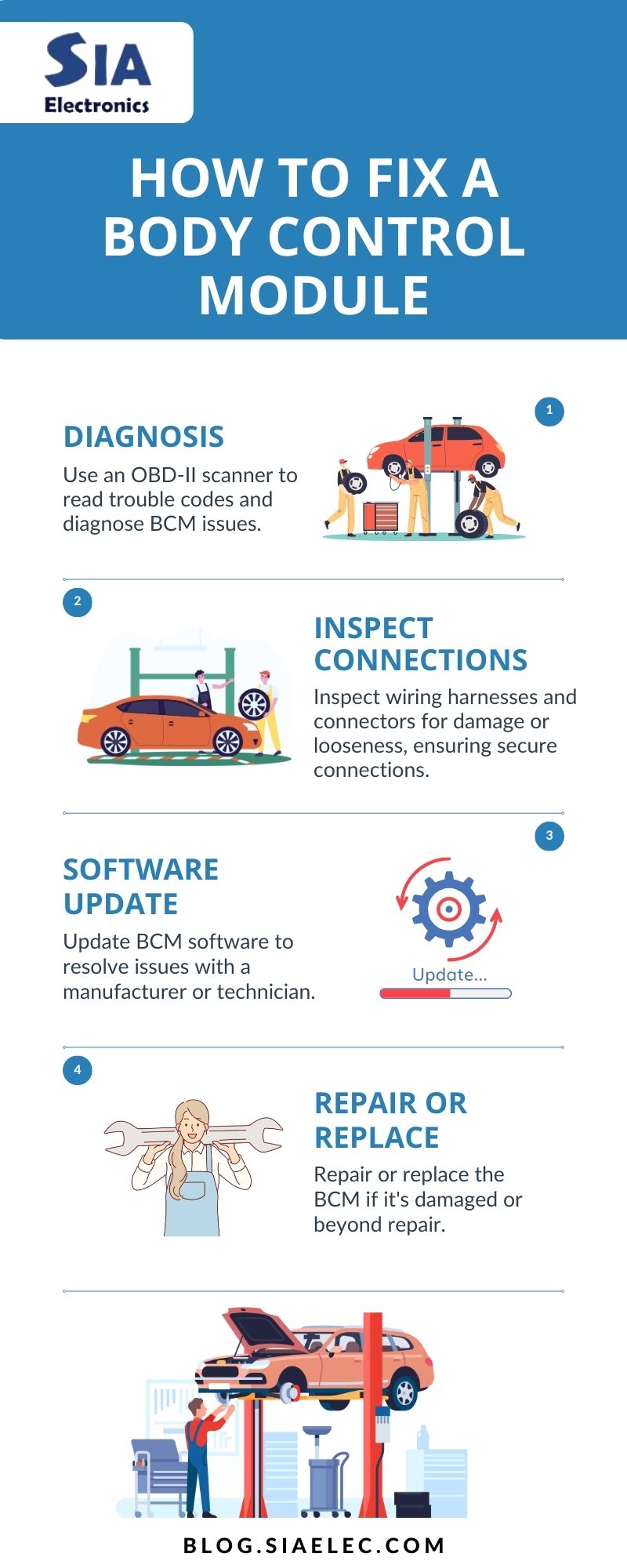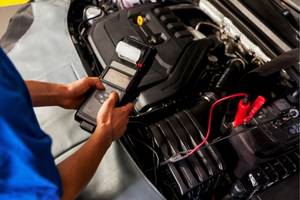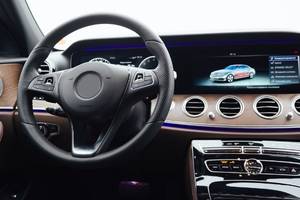Introduction
A Body Control Module (BCM) is a critical component in modern vehicles, responsible for managing various electrical systems and functions. When the BCM goes bad, it can lead to a range of issues that affect the vehicle's performance and safety. This blog will delve into what happens when a Body Control Module goes bad, the symptoms of a failing BCM, and the steps to address and resolve BCM issues. As industry leaders with over 20 years of experience, SIA Electronics provides expert solutions in the re-manufacturing of automotive electronic control modules and ECUs.
Table of Contents
What is a Body Control Module?
A Body Control Module (BCM) is an electronic control unit in vehicles that manages and regulates various electrical systems, including lighting, power windows, door locks, and more. It acts as the central hub for these systems, processing signals from sensors and switches to ensure proper operation. The BCM is essential for coordinating the vehicle's electrical functions and ensuring they work seamlessly.
Key Functions of a BCM:
- Lighting Control: Manages interior and exterior lighting systems.
- Window and Door Controls: Regulates power windows, door locks, and mirrors.
- Climate Control: Interfaces with the HVAC system to control air conditioning and heating.
- Security Systems: Integrates with alarm systems and immobilizers to enhance vehicle security.
Symptoms of a Failing Body Control Module
When a BCM malfunctions, it can manifest through various symptoms that impact the vehicle's electrical systems. Here are some common signs that indicate a failing BCM:
- Electrical Failures
- Malfunctioning Lights: Flickering, dim, or non-functional headlights, taillights, or interior lights.
- Inconsistent Power Window Operation: Windows that move slowly or not at all.
- Erratic Door Locks: Doors that lock or unlock intermittently or fail to respond.
- Dashboard Warning Lights
- Illuminated Warning Lights: Unexpected or persistent warning lights on the dashboard, such as the battery light or check engine light.
- Climate Control Issues
- Inoperative HVAC System: Air conditioning or heating that does not function properly.
- Problems with Keyless Entry
- Unresponsive Key Fob: Difficulty unlocking or locking the vehicle using a remote key fob.
- Performance Issues
- Unusual Vehicle Behavior: Inconsistent or unresponsive electrical functions affecting overall vehicle performance.
How to Fix a Body Control Module
Fixing a malfunctioning BCM can involve several approaches, depending on the severity of the issue. Here are the common steps to address BCM problems:
- Diagnosis
- Use Diagnostic Tools: Employ an OBD-II scanner to read trouble codes related to the BCM. This helps identify the specific issues.
- Inspect Connections
- Check Wiring and Connectors: Inspect wiring harnesses and connectors for damage or loose connections. Ensure all connections are secure.
- Software Update
- Perform Software Updates: Sometimes, BCM issues can be resolved with a software update from the manufacturer or a qualified technician.
- Repair or Replace
- Repair the BCM: If possible, repair the BCM or its components. This might involve soldering connections or replacing faulty components.
- Replace the BCM: If the BCM is beyond repair, replacement with a new or re-manufactured module is necessary.
Steps to Reset a Body Control Module
Resetting the BCM can sometimes resolve issues related to minor glitches or software errors. Here are the steps to reset the BCM:
- Disconnect the Battery
- Turn off the Engine: Ensure the vehicle is off.
- Disconnect the Negative Battery Terminal: Leave it disconnected for at least 15 minutes to allow any residual power to dissipate.
- Reconnect the Battery
- Reattach the Negative Battery Terminal: Secure it properly and ensure a good connection.
- Turn on the Ignition
- Start the Vehicle: Turn the ignition to the "On" position and let it run for a few minutes to allow the BCM to reset and reinitialize.
- Check for Issues
- Test Functions: Verify that the electrical systems are functioning correctly and that any warning lights have cleared.
Body Control Module Replacement Cost
The cost of replacing a BCM can vary depending on several factors, including the make and model of the vehicle, the availability of parts, and labor costs. Here’s a general breakdown:
- Parts Cost
- New BCM: $200 to $1,000, depending on the vehicle's make and model.
- Re-manufactured BCM: Often less expensive, ranging from $150 to $700.
- Labor Costs
- Diagnostic and Labor: Typically $100 to $200 per hour, with the total labor cost depending on the complexity of the replacement process.
- Total Replacement Cost
Estimated Total: $300 to $1,500, including parts and labor.
Conclusion
A malfunctioning Body Control Module (BCM) can lead to a range of issues affecting a vehicle's electrical systems and overall performance. Understanding the symptoms of a failing BCM, the steps to address and repair it, and the associated costs can help you manage BCM issues effectively. At SIA Electronics, we specialize in the re-manufacturing of automotive electronic control modules and ECUs, offering reliable solutions for all domestic and foreign vehicles. With over 20 years of experience, we provide expert services to ensure your vehicle operates smoothly and efficiently.
FAQs on
What Happens When a Body Control Module Goes Bad?
-
1. What are the common symptoms of a failing Body Control Module (BCM)?
Ans.
Symptoms of a failing BCM include malfunctioning lights (flickering, dim, or non-functional), inconsistent power window operation, erratic door locks, illuminated dashboard warning lights, inoperative HVAC systems, issues with keyless entry, and unusual vehicle behavior affecting overall performance.
-
2. How can I diagnose a malfunctioning BCM?
Ans.
To diagnose a malfunctioning BCM, use an OBD-II scanner to read trouble codes related to the BCM. This helps identify specific issues. Additionally, inspect wiring and connectors for damage or loose connections, and consider performing a software update if recommended.
-
3. What steps should I take to reset a Body Control Module?
Ans.
To reset a BCM, first disconnect the negative battery terminal and leave it disconnected for at least 15 minutes. Reconnect the battery terminal securely, then start the vehicle and let it run for a few minutes to allow the BCM to reset and reinitialize.
-
4. How much does it typically cost to replace a Body Control Module?
Ans.
The cost of replacing a BCM typically ranges from $300 to $1,500. This includes the cost of parts, which can be $200 to $1,000 for a new BCM or $150 to $700 for a re-manufactured BCM, plus labor costs of $100 to $200 per hour.
-
5. Can a failing BCM affect my vehicle's safety features?
Ans.
Yes, a failing BCM can affect various safety features such as lighting systems, power windows, door locks, and security systems. This can potentially lead to reduced vehicle safety and increased risk of accidents.
-
6. What should I do if my vehicle shows symptoms of a BCM issue?
Ans.
If your vehicle shows symptoms of a BCM issue, start by diagnosing the problem using an OBD-II scanner and inspecting connections. Depending on the severity, you may need to update the BCM's software, repair it, or replace it entirely. Consider seeking professional help for accurate diagnosis and repair.



